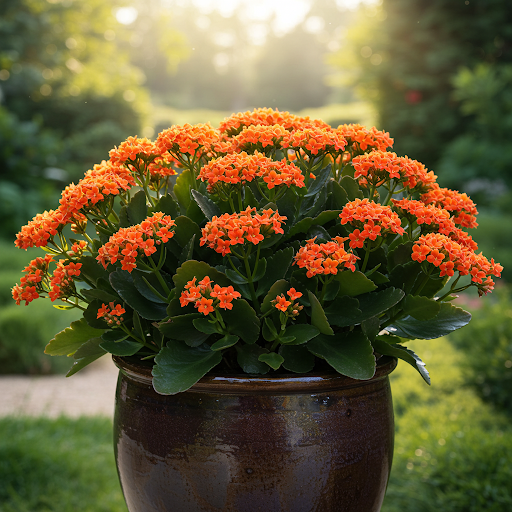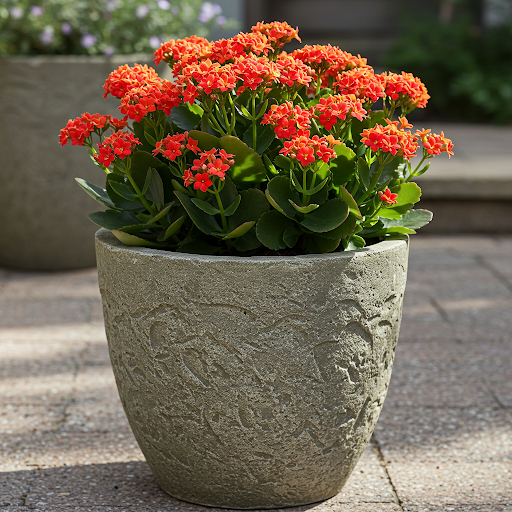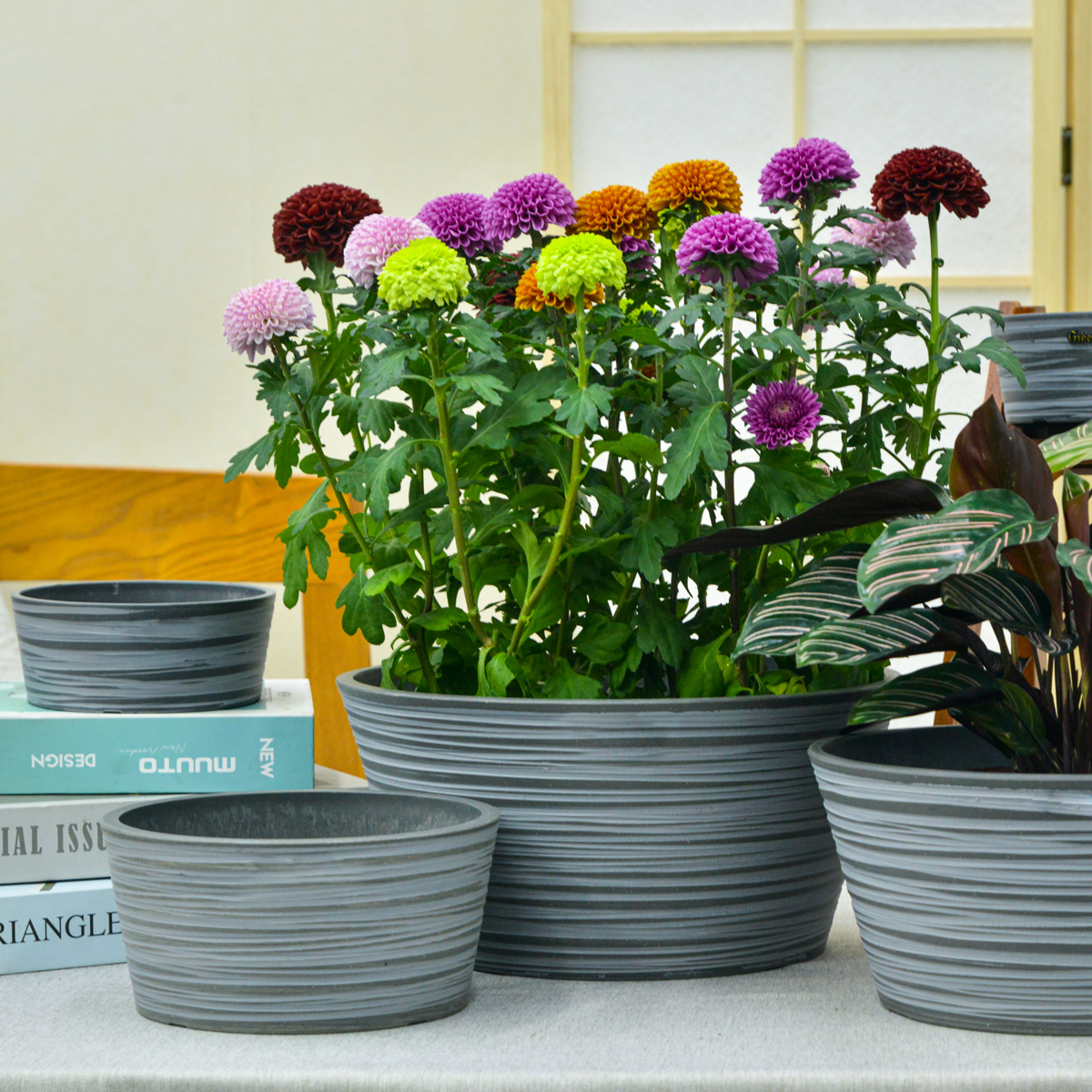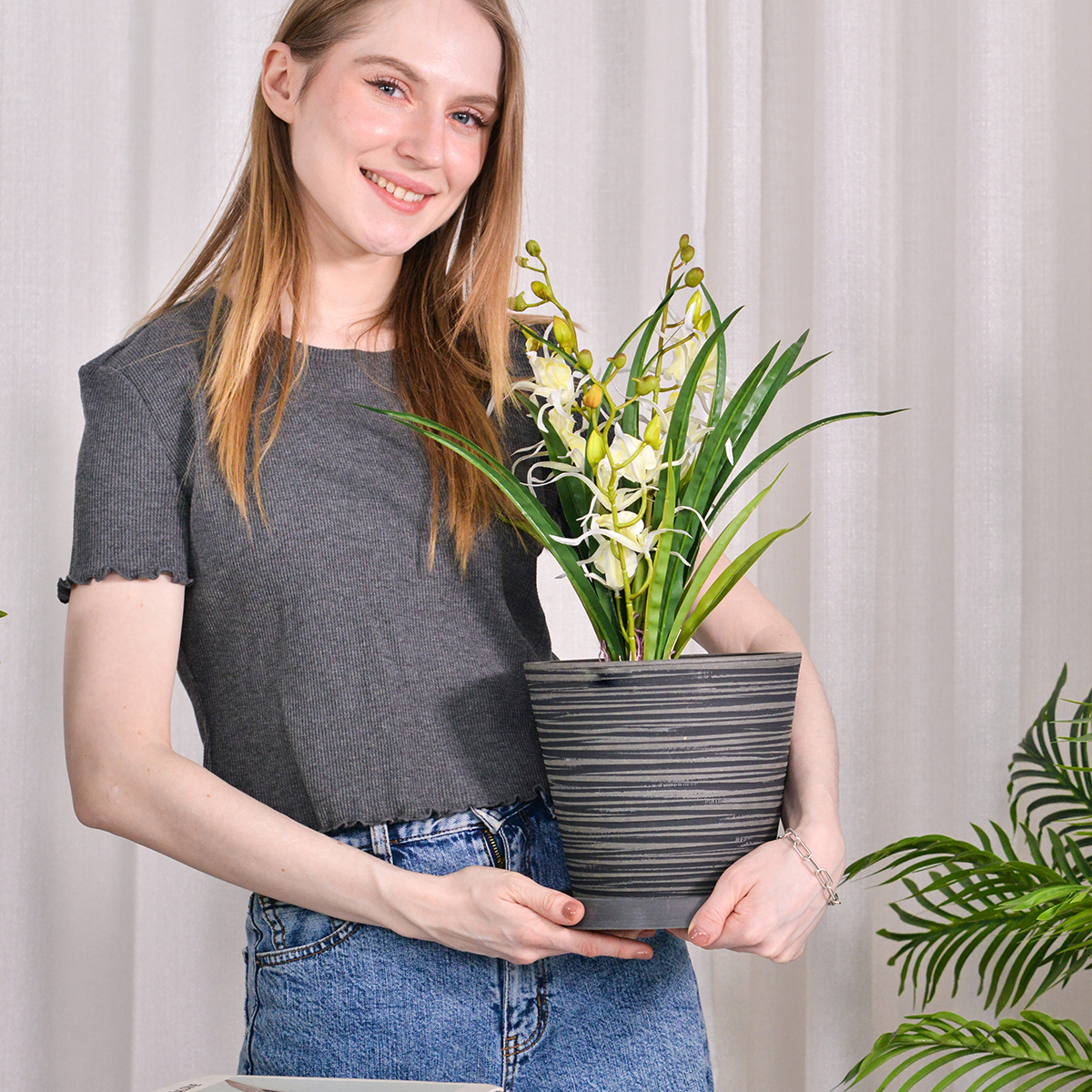Flaming Katy in Pots: The Complete Guide to Growing Kalanchoe Outdoors in Containers (Long-Lasting Blooms!)
Want to add a splash of vibrant, long-lasting color to your patio, balcony, or garden? Growing Flaming Katy (Kalanchoe blossfeldiana) in containers is a wonderfully easy and rewarding way to bring these cheerful succulents into your outdoor spaces. Celebrated for their clusters of bright, petite flowers that last for weeks, their succulent foliage, their low-maintenance nature, and their adaptability to container gardening, Flaming Katy (also known as Florist Kalanchoe or Christmas Kalanchoe, and 长寿花 in Chinese) is perfect for adding a touch of enduring color to your outdoor living areas. This comprehensive guide will provide you with everything you need to know to grow Kalanchoe blossfeldianasuccessfully in outdoor pots, from selecting the best plants and containers to mastering essential care techniques for a vibrant and extended floral display.

Flaming Katy
What is Flaming Katy (Kalanchoe Blossfeldiana)?
Flaming Katy, scientifically known as Kalanchoe blossfeldiana, is a popular succulent flowering plant belonging to the Crassulaceae family. Native to Madagascar, it is widely cultivated as an ornamental plant, both indoors and outdoors, prized for its long-lasting, brightly colored flowers, succulent foliage, drought tolerance, and ease of care. Flaming Katy plants are characterized by their succulent, fleshy leaves that are typically dark green, scalloped, and oval-shaped, and clusters of small, four-petaled flowers held in dense corymbs above the foliage. Flowers come in a wide range of colors, including red, pink, orange, yellow, white, and bi-colors. They exhibit a compact, bushy growth habit, typically reaching heights of 6-12 inches and spreading 6-12 inches wide, making them ideal for pots and smaller spaces. They are known for their prolific and long-lasting blooms, drought tolerance, ease of propagation, and adaptability to container culture, making them a popular choice for homes, patios, balconies, and as gifts, especially for adding cheerful, low-maintenance color. In Chinese culture, it is known as 长寿花 (Chángshòuhuā), meaning “long-life flower,” symbolizing longevity, prosperity, and good health, making it a particularly auspicious plant.
Is Flaming Katy (Kalanchoe Blossfeldiana) Good for Outdoor Pots?
Yes, Flaming Katy is exceptionally well-suited for outdoor pots and container gardening, and is a fantastic choice for adding color to patios, balconies, and other outdoor areas, especially in warm climates like Singapore. Their drought tolerance, compact size, long bloom time, and adaptability to pot culture make them ideal for container gardens. Growing Flaming Katy in pots offers several advantages:
- Excellent Drought Tolerance: Flaming Katy is highly drought-tolerant, making it perfect for water-wise gardening and for container culture where watering can be easily managed.
- Portability: Potted Flaming Katy can be easily moved to optimal locations for sunlight, display, or shelter from extreme weather (though they are quite resilient). You can rearrange them to create colorful displays as desired.
- Controlled Environment: Container gardening allows you to provide the fast-draining soil mix that Flaming Katy requires and control watering and fertilization precisely, which is crucial for succulents.
- Design Versatility: Flaming Katy works beautifully as a standalone specimen plant in a decorative pot, or as part of a mixed succulent container arrangement, adding vibrant color and textural contrast.
- Pest and Disease Management: Container growing can help reduce some soilborne pest and disease issues that can affect Flaming Katy planted directly in the ground.
- Ideal for Sunny Locations: Flaming Katy thrives in sunny locations, making them perfect for patios, balconies, and rooftop gardens where they can receive ample light for best flowering.
- Cold Climate Flexibility: In regions with colder winters, potted Flaming Katy can be easily moved indoors to a bright, cool location to protect them from frost and freezing temperatures, and then brought back outdoors in warmer months to enjoy their blooms. (Though this is not necessary in Singapore).
Ideal Growing Conditions for Flaming Katy (Kalanchoe Blossfeldiana) in Pots:
Light: Flaming Katy thrives in bright sunlight. When grown outdoors, it appreciates full sun for most of the day to encourage abundant flowering and vibrant foliage color. It can tolerate partial shade, especially during the hottest part of the afternoon in very intense summer climates, but full sun is generally best for optimal bloom production. Choose a sunny location for your Flaming Katy containers, such as a south-facing patio, balcony, or garden. Inadequate light can result in fewer flowers and weaker, leggier growth.
Soil: Flaming Katy requires fast-draining soil that is typical for succulents and cacti. Use a high-quality cactus and succulent potting mix. You can further amend this mix with perlite, pumice, or coarse sand to enhance drainage even more. Excellent drainage is absolutely crucial to prevent root rot, which is a common issue with Kalanchoes. Avoid regular potting soil or garden soil, as these retain too much moisture. A slightly acidic to neutral pH (around 6.0-7.0) is ideal.
Watering: Flaming Katy is drought-tolerant and prefers infrequent but thorough watering. Allow the soil to dry out almost completely between waterings. When watering, water deeply until water drains freely from the drainage holes. Then, allow the soil to become quite dry before watering again. Overwatering is the biggest riskfor Flaming Katy and can quickly lead to root rot. During the active growing and blooming season (spring and summer), you may water every 1-2 weeks, depending on weather conditions and pot size. In the dormant season (fall and winter), reduce watering significantly, watering perhaps once a month or even less, only enough to prevent the leaves from shriveling excessively. In Singapore’s humid climate, ensure pots are not sitting in standing water after rain. Err on the side of underwatering.
Temperature: Flaming Katy thrives in warm temperatures, ideally between 65-80°F (18-27°C) during the growing season. It is a succulent and is not frost-hardy. In Singapore’s consistently warm climate, temperature is generally ideal for Flaming Katy year-round. It can tolerate slightly higher temperatures, but avoid prolonged exposure to temperatures below 50°F (10°C). Consistent warm temperatures are beneficial for their growth and flowering.
Humidity: Flaming Katy is adapted to arid and semi-arid environments and prefers low to moderate humidity. Singapore’s humidity might be higher than its ideal, but Flaming Katy is adaptable. Ensure good air circulation around the plant and avoid overly humid microclimates. Good drainage and proper watering are even more important in humid climates to prevent root rot.
Fertilizer: Flaming Katy is not a heavy feeder and generally does not require frequent fertilization, especially when grown in pots. Over-fertilizing can lead to weak growth and fewer flowers. If desired, you can apply a very dilute, balanced fertilizer (e.g., 10-10-10) once or twice during the active growing season (spring/summer), especially if plants are blooming heavily. Dilute the fertilizer to half or even quarter strength of the recommended dosage for typical houseplants. Alternatively, you can use a cactus and succulent fertilizer according to label directions, but still use it sparingly. Avoid high-nitrogen fertilizers. Fertilizing is often optional, especially if you repot annually into fresh succulent mix.
Choosing the Right Pots for Flaming Katy (Kalanchoe Blossfeldiana):
Suitable Pot Types: Drainage is the most critical factor when choosing pots for Flaming Katy. Pot types that promote excellent drainage and aeration are best:
- Terracotta Pots: Terracotta is an excellent choice for Flaming Katy. It is porous, allowing for excellent aeration and drainage, and helps the soil dry out quickly, which succulents prefer. Terracotta also provides a classic, natural look that complements succulents.
- Unglazed Ceramic Pots: Unglazed ceramic pots offer similar breathability to terracotta and are a good option.
- Clay Pots: Similar to terracotta, clay pots promote good drainage and aeration.
- Plastic Pots (with caution): Plastic pots can be used, but they retain more moisture than terracotta. If using plastic, be extra vigilant about watering and ensure the potting mix is very fast-draining. You might consider adding even more perlite or pumice to the mix when using plastic pots.
- Avoid Glazed Ceramic or Metal Pots (unless drainage is excellent): Glazed ceramic pots and metal pots can retain too much moisture and may not be ideal unless you are very careful with watering and ensure exceptional drainage and very fast-draining soil.
Drainage: Excellent drainage is non-negotiable for Flaming Katy. Ensure your chosen pot has at least one, and preferably multiple, drainage holes at the bottom. Avoid pots without drainage holes. Always use a drainage layer at the base of the pot (e.g., a layer of gravel, pot shards, or clay pebbles) beneath the potting mix to further enhance drainage. Elevating pots slightly on pot feet or bricks can also improve drainage and air circulation.
Pot Size: Choose pot sizes appropriate for the size of your Flaming Katy and your desired display. Flaming Katy is a relatively compact plant and doesn’t need very large pots.
- Small to Medium Pots (Most Common): For most Flaming Katy plants, pots that are 4-8 inches in diameterare generally suitable. The pot should be proportionate to the size of the plant. Overpotting can increase the risk of root rot.
- Group Plantings: For planting multiple Flaming Katy plants together in a larger display, use wider pots or succulent bowls that are 10 inches in diameter or larger.
- Depth: Pot depth is less critical than drainage, but choose pots that are at least 4-6 inches deep to accommodate the root system.
Stability: Flaming Katy is a relatively small and compact plant and does not typically require exceptionally heavy or wide pots for stability. Standard pots are generally stable enough.
Color and Style: Choose pot colors and styles that complement the vibrant flower colors of your Flaming Katy and your outdoor décor, and enhance their cheerful, succulent appearance. Neutral tones like terracotta, white, gray, or natural tones often work well, allowing the bright flowers to stand out. Brightly colored pots can also be used for a more vibrant and festive display. Consider the overall style of your patio or balcony and choose pots that harmonize with the surroundings and enhance the desired cheerful, succulent garden ambiance.
Essential Care Tips for Thriving Flaming Katy (Kalanchoe Blossfeldiana) in Outdoor Pots:
- Watering: “Water Sparingly, Allow Soil to Dry Completely Between Waterings”. Water deeply but infrequently, only when the soil is almost completely dry. Avoid overwatering at all costs. Reduce watering significantly in fall and winter.
- Sunlight: Provide Full Sun for Best Blooms and Color. Place Flaming Katy pots in a location that receives full sun for most of the day. Full sun is essential for abundant flowering and vibrant colors.
- Fertilizing: Fertilize Very Sparingly, Once or Twice a Year (Optional). Fertilize lightly, if at all, only once or twice during the growing season with a very dilute balanced or succulent fertilizer. Over-fertilizing is worse than under-fertilizing.
- Deadheading (Optional, for Neatness): Deadheading spent flower clusters is not strictly necessary, as they will eventually dry and fall off. However, you can remove spent flower heads for a tidier appearance and to potentially encourage further blooming.
- Pruning (Minimal Pruning Needed): Minimal pruning is needed. You can trim back any leggy stems or spent flower stalks to maintain a compact shape.
- Flowering Cycle (Short Day Plant, Reblooming): Flaming Katy is a short-day plant, meaning it naturally blooms in response to longer periods of darkness. After a bloom cycle, it may need a period of shorter days (longer nights) to rebloom. To encourage reblooming, you can try providing it with about 12-14 hours of darkness each day for several weeks. However, many modern cultivars are less dependent on day length and may rebloom more readily under normal conditions, especially with proper care.
- Pest and Disease Control: Flaming Katy is relatively pest and disease resistant. Monitor for common succulent pests like mealybugs or aphids, though they are not usually a major problem outdoors. Root rot is the most common disease issue, caused by overwatering. Prevent root rot by ensuring excellent drainage and proper watering practices.
Popular Flaming Katy Cultivars (and Flower Colors):
Flaming Katy cultivars are primarily distinguished by their flower colors and flower form (single or double). Many series are available with a wide color range.
- Common Flower Colors: Red, Pink, Orange, Yellow, White, Magenta, Coral, Lavender, Bi-colors. Choose colors that suit your preference.
- Double Flowered Varieties: Some cultivars feature double or semi-double flowers, offering a fuller, more ruffled appearance. Look for series or cultivars described as “double flowering.”
- Series Names (Wide Color Ranges): Many cultivars are sold within series, such as ‘Calandiva’ series (known for double flowers), ‘Leonardo’ series, ‘Magic Bells’ series (bell-shaped flowers), ‘Paris’ series, and others. These series offer a range of colors within a specific flower form or plant habit.
In Summary:
Growing Flaming Katy (Kalanchoe blossfeldiana) in outdoor pots is a wonderfully easy and rewarding way to add a splash of long-lasting, vibrant color to your patio, balcony, or garden. Their cheerful flower clusters, succulent foliage, and low-maintenance nature make them a perfect choice for container gardeners of all levels, especially those in warm, sunny climates or those seeking drought-tolerant, easy-care color. By providing full sun, fast-draining potting mix in pots with excellent drainage, watering sparingly and allowing the soil to dry out completely between waterings, and minimal fertilization, you can easily cultivate thriving and beautifully blooming Flaming Katy plants in pots and enjoy their enduring floral display in your outdoor living spaces for weeks on end.

Flaming Katy
For more detailed botanical information and to explore the diverse world of Kalanchoe blossfeldiana (Flaming Katy), you can visit the Wikipedia page on Kalanchoe blossfeldiana.
Important Note: The key to success with Flaming Katy is to avoid overwatering. Always allow the soil to dry out almost completely between waterings and ensure excellent drainage in your pots. With proper care and plenty of sunshine, your potted Flaming Katy will thrive outdoors and bring weeks of cheerful color to your home!
20VD
By greenship|2024-08-13T06:43:41+00:00August 13, 2024|Categories: Hand-carving Series|
20T
By greenship|2024-08-13T06:42:22+00:00August 13, 2024|Categories: Hand-carving Series|
11THD
By greenship|2024-08-13T02:52:20+00:00August 13, 2024|Categories: Hand-carving Series|
Modern Plant Pots丨Planter for Indoor Plants,8 inch or 10 inch Plant Pots with Drainage Hole,Decorative Flower Pots
By greenship-seo|2025-04-10T08:32:55+00:00January 7, 2025|Categories: Hand-carving Series|Tags: Decorative Flower Pots, Self-Watering Pots|
HS
By greenship|2024-08-13T06:45:17+00:00August 13, 2024|Categories: Hand-carving Series|
K2-11T
By greenship|2024-08-13T04:21:25+00:00August 13, 2024|Categories: Hand-carving Series|






